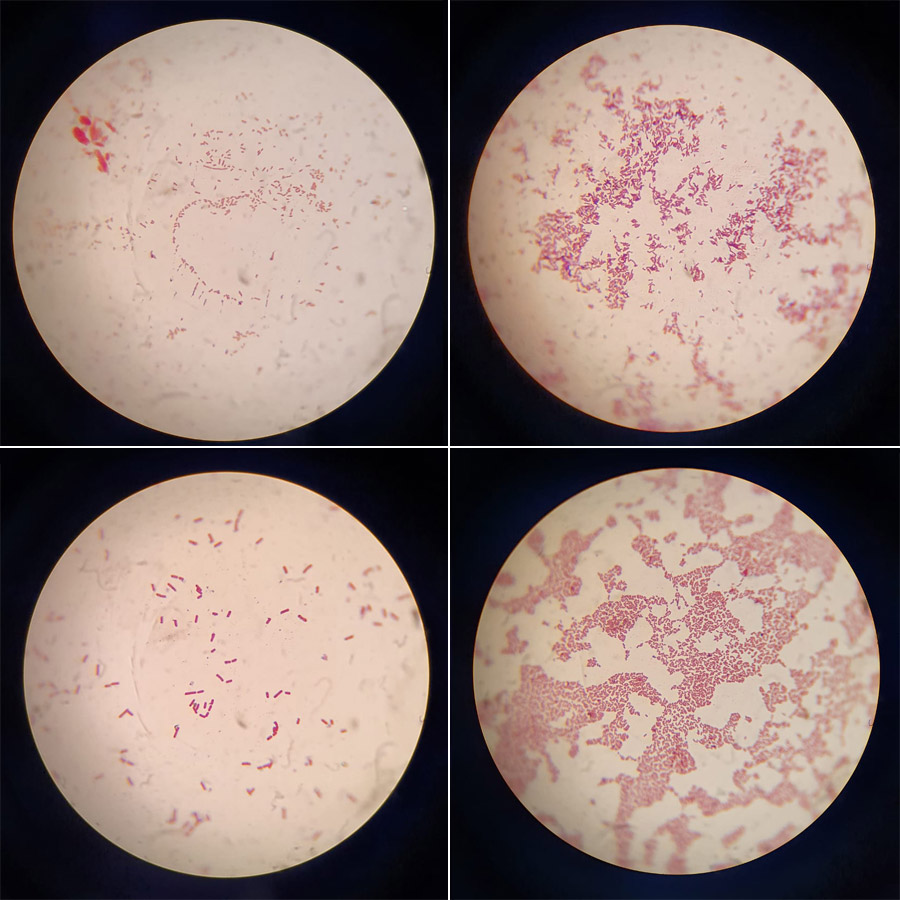Vegetation of the UAE that has been shown to interact with biotic components of the soil.
Left: Salt cedar (https://www.dm.gov.ae/rakws_animal_listing/salt-cedar/)
Middle: White saxaul (https://connectwithnature.ae/knowledge-hub/white-saxaul)
Right: Ghaf tree and longhorn beetle (Ajmal Hasan 2014. https://outdooruae.com/outdoor-activity/otheractivities/beetling-about-…)
Soil biodiversity in the UAE
More than 800 species of plants (including multiple halophytic plants), 48 species of wild mammals, 440 species of birds, 72 species of reptiles and amphibians, along with rich coral reef areas have been recorded in the UAE. This includes trees such as the ghaf, samur, salt cedar and Arabian gum tree, shrubs as rimth and ghada, birds such as the greater hoopoe-lark, black-crowned sparrow-lark, crested lark, southern grey shrike and cream-colored courser, and various other animals such as the sand cat, Arabian oryx, sand gazelle, Arabian tahr, red fox, caracal, horned viper, camel spider, black fat-tailed scorpion and many others. We know that the salt cedar dramatically increases the salinity of the surface of the soil around them, making it inhospitable to other plant species. We also know that the white saxaul (ghada) possesses an extensive root system, which helps stabilize sandy soil and reduce desertification. We know that the larvae of longhorn beetles live for long periods of time in the soil near ghaf trees, boring into roots or rhizomes before they become mature and live inside holes in the tree. Despite these examples, the soil biodiversity of the UAE remains largely uncharted. Future directions should include the exploration of the biodiversity of the UAE soils to better understand their dynamics and guide favorable soil management strategies.
Abu Dhabi sabkha
A specific soil type, rich in anhydrite (anhydrous calcium sulfate; chemical formula: CaSO4) was described in a coastal sabkha south of Abu Dhabi. X-ray diffraction confirmed that anhydrite is the dominant mineral in coastal sabkha soils, with the absence of gypsum. Sabkhas are flat areas rich in minerals that resulted from evaporite precipitation. This sabkha is the only one in the world that contains the four main distinctive layers of this type of salt flat: lagoon mud (subtidal), microbial mat (intertidal), gypsum mud and anhydrite nodules (supratidal). Interestingly, sabkhas have been proposed as analogs of a potential Mars ecosystem.
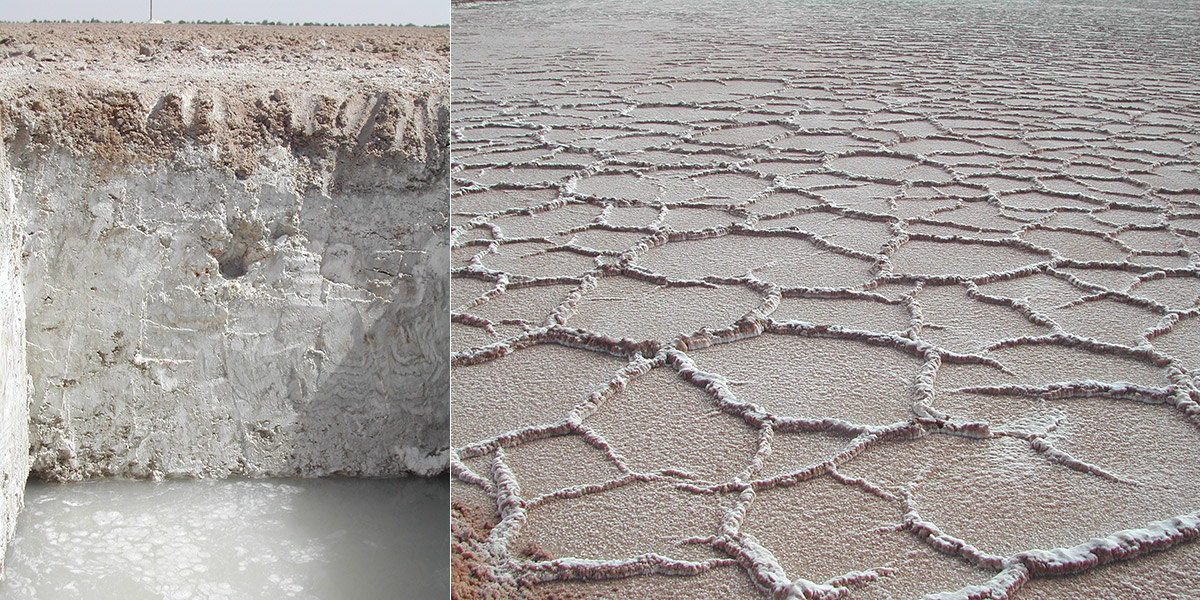
Field photographs from ICBA & EAD Abu Dhabi soil surveys 2006-2009
The microbial mats of sabkhas are particularly pronounced since the harsh nature of this system limits the occurrence of grazing fauna. These microbial mats form distinctive polygon-shaped, desiccated mounds and are known to become solid rock over geological time scales. The prokaryotic diversity of mats from the Abu Dhabi sabkha has been determined to be mainly formed by Cyanobacteria in the lower intertidal zone, although representatives of Spirochaetes, Proteobacteria, Bacteroidetes, Firmicutes, Acidobacteria and Actinobacteria bacterial phyla, and members of the Archaea, were also found. Microbial community structures appeared to be associated with the intertidal zone and salinity changes. Moreover, it has been suggested that these microbes could be involved in the formation process of the mineral dolomite.
Interesting fact: Sabkhas and their microbial mats have been shown to contain significant pools of carbon.
Furthermore, a recent study investigated the microbial mats of interdune sabkhas among large dunes in the Rub' al Khali (‘Empty Quarter’), more precisely in the Liwa Oasis. Different layers of mats obtained from the collection sites showed a distinct microbial composition: the top and middle layers were dominated by the phylum Bacteroidetes, while the bottom and sediment layers showed a higher fraction of Cyanobacteria and Proteobacteria, respectively.
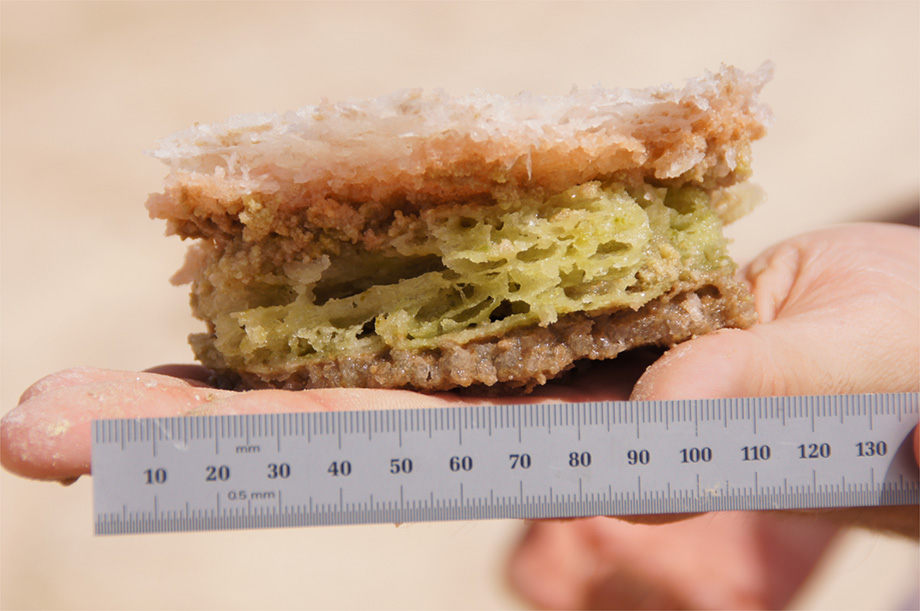
Close-up of an endoevaporite mat from sabkhas in the Liwa Oasis. The uppermost white layer, about 5 mm thick, is the salt crust. Below that is a layer, almost 5 mm thick of pink halophilic bacteria and below that a layer of green photosynthetic organisms. Below the green layer the material is darker in color. McKay et al (2016) PLoS One (https://journals.plos.org/plosone/article?id=10.1371/journal.pone.0150342)
Current and future work: As microbes collected in sabkhas and other desert landscapes have evolved to tolerate extreme conditions of temperature, salinity, moisture, pH, …), their properties have been pursued for various applications in biotechnology. The field of research in which scientists specifically search for useful products derived from bioresources is called bioprospection.
Can microbes recovered from the mango rhizosphere in the UAE be useful as biological control agents against fungal pests?
The soil biodiversity of the rhizosphere (soil region around the plant roots) of mango plantation in the UAE was studied by Kamil and colleagues. A total of 53 Actinobacteria isolates were isolated from a 30 cm depth under healthy mango trees, 2/3 of which were classified as Streptomyces. Interestingly, 19 of the isolates demonstrated to possess antagonistic activities against the fungus Lasiodiplodia theobromae, a pathogen that afflicts mango plants by causing the mango dieback disease. The strain of L. theobromae used in this study had previously been isolated from diseased tree twigs in Abu Dhabi.
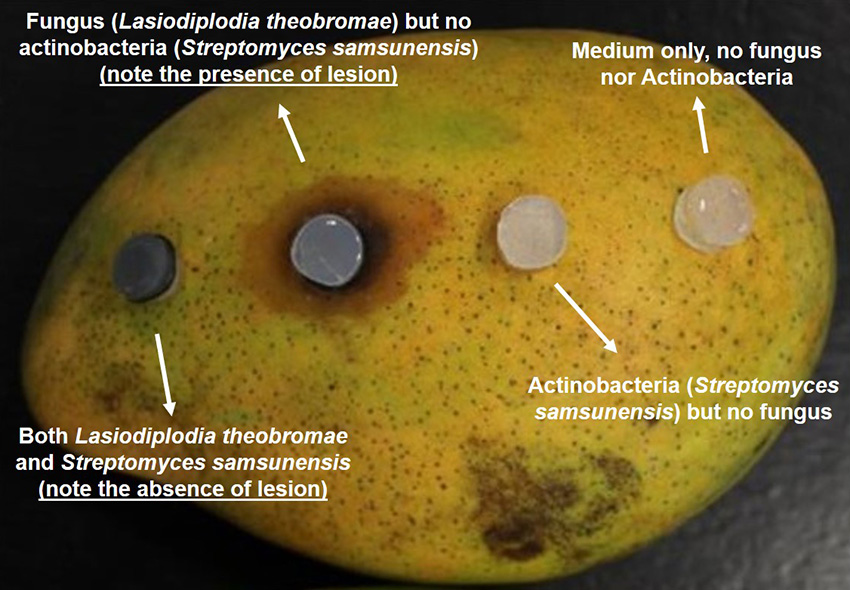
In vivo inhibitory effect of a biological control Streptomyces candidate against Lasiodiplodia theobromae using a mango fruit bioassay. Adapted from: Kamil et al (2018) Frontiers in Microbiology (https://www.frontiersin.org/articles/10.3389/fmicb.2018.00829/full)
From these 19 candidates, three strains from the species Streptomyces samsunensis, Streptomyces cavourensis and Micromonospora tulbaghiae showed the strongest inhibitory effects, and conferred disease protection in mango seedlings infected with L. theobromae in greenhouse experiments. This study showed for the first time that soil Actinobacteria have the potential to counteract an important fungal pathogen, L. theobromae, that causes plant dieback in a variety of hosts, including mango, guava, coconut, papaya, and grapevine.
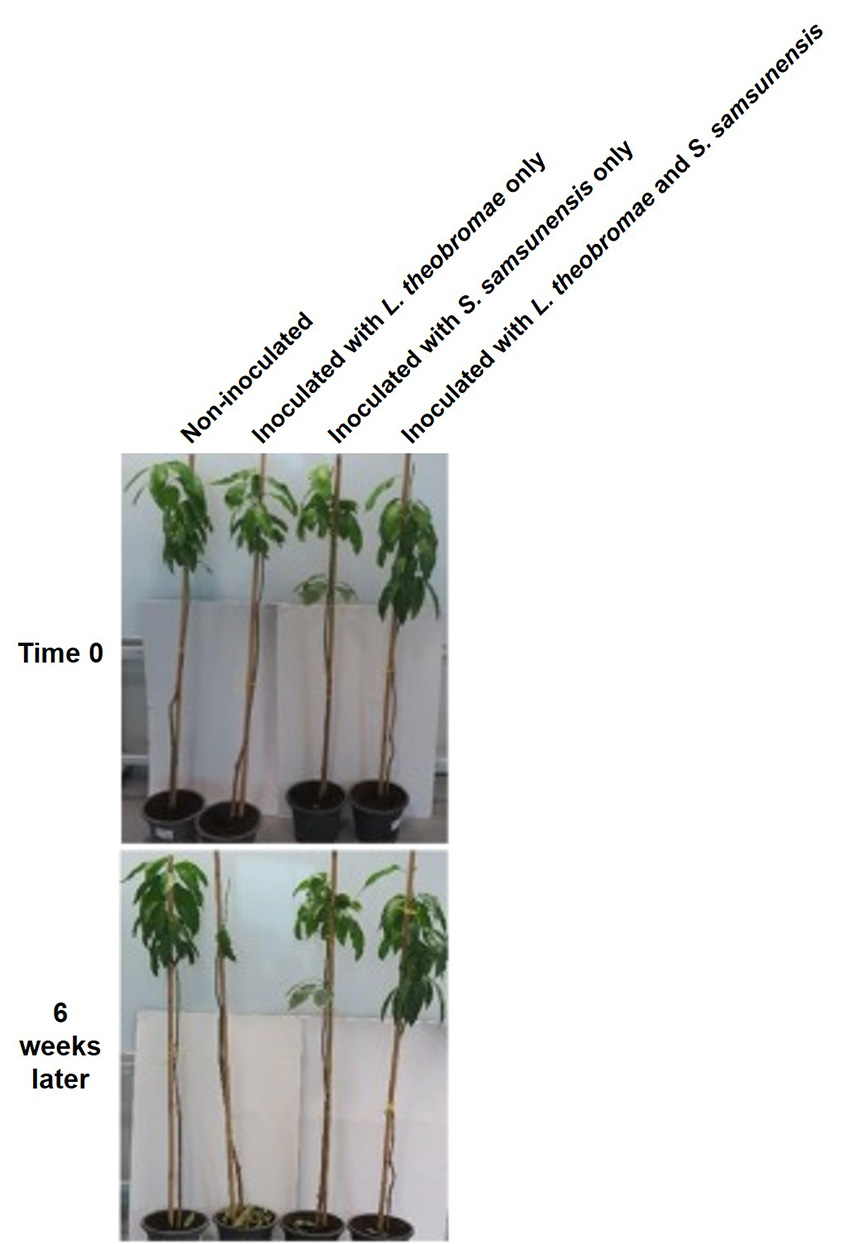
Antagonistic effect of a biological control Streptomyces candidates against mango dieback disease under greenhouse conditions. Adapted from: Kamil et al (2018) Frontiers in Microbiology (https://www.frontiersin.org/articles/10.3389/fmicb.2018.00829/full)
How does oil pollution in mangroves of the UAE affect microbial activity in soil sediments?
El-Tarabily reported an analysis of sediment samples from oil-polluted and nonpolluted mangrove sites in the UAE which were analyzed for their microbial activity and composition (for culturable organisms). The total population of bacteria, filamentous fungi and yeast was significantly lower in the oil-polluted sediment in comparison with the nonpolluted sediment. This tendency was further supported by the observation that the addition of water-soluble fractions of the light Arabian crude oil to the nonpolluted sediment caused a reduction in microbial activity.
Additional examples
Images of bacterial cultivations from the rhizosphere of ghaf trees (Prosopis cineraria). Soil depth: 20-30 cm. Gram staining. Image credits: Dr. Sumitha Thushar, Shreya Prajapat, and Sirisha Nuti, International Center for Biosaline Agriculture (ICBA).
